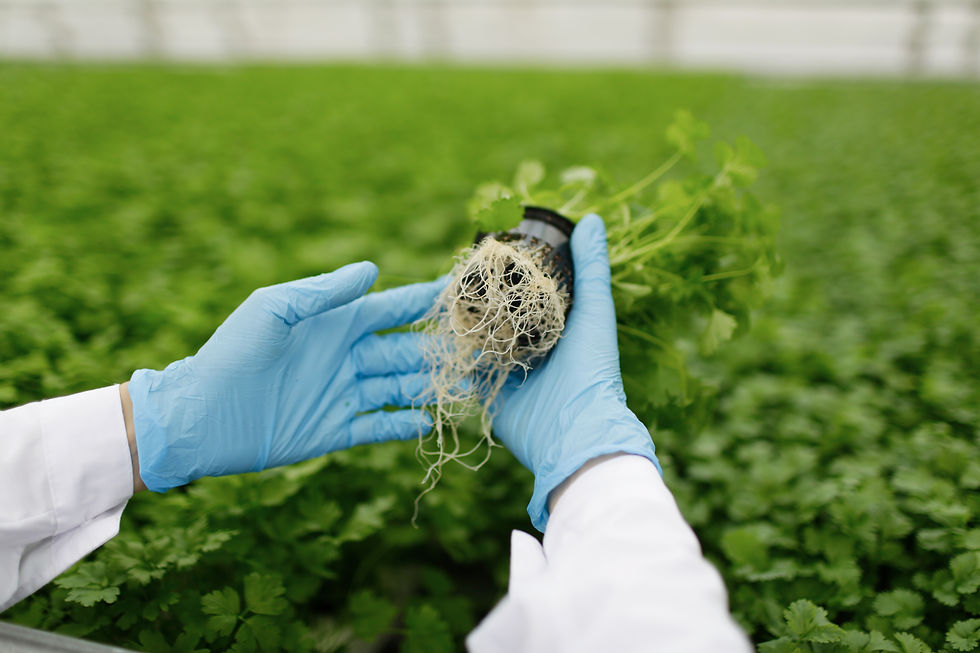How Does Rhizophagus Intraradices Help Your Plants Grow in Summer?
- universalmicrobesu
- Jun 11, 2024
- 3 min read

Summer can be a challenging time for gardeners and farmers alike. The scorching heat, high temperatures, and occasional water shortages can stress plants, leading to poor growth and reduced yields. However, there's a natural solution that can help your plants thrive even in the hottest months: Rhizophagus Intraradices.
What is Rhizophagus Intraradices?
Rhizophagus Intraradices, also known as Rhizophagus Irregularis, is a type of mycorrhizal fungus. Mycorrhizae are beneficial fungi that form symbiotic relationships with plant roots. These fungi colonize plant roots and extend far into the soil, helping plants absorb water and nutrients more efficiently. Rhizophagus Intraradices is one of the most widely used and effective mycorrhizal fungi in agriculture and horticulture.
How Does Rhizophagus Intraradices Work?
The symbiotic relationship between Rhizophagus Intraradices and plants is mutually beneficial. The fungus receives carbohydrates and sugars produced by the plant through photosynthesis. In return, the fungus helps the plant by:
Enhancing Nutrient Uptake:
Rhizophagus Intraradices extends the root system by forming a network of hyphae (fungal filaments) that penetrate the soil. This network increases the surface area for nutrient absorption.
It helps in the uptake of essential nutrients like phosphorus, nitrogen, potassium, and micronutrients such as zinc and copper, which are crucial for plant growth and development.
Improving Water Absorption:
The extended root network created by Rhizophagus Intraradices allows plants to access water from a larger soil volume.
This is particularly beneficial during the summer when water availability can be limited. The fungus helps plants maintain hydration, reducing the risk of drought stress.
Boosting Plant Resilience:
Plants colonized by Rhizophagus Intraradices are more resilient to environmental stresses such as high temperatures, drought, and soil salinity.
The fungus helps plants produce stress-related hormones and compounds that improve their ability to withstand adverse conditions.
Enhancing Soil Structure:
The hyphae of Rhizophagus Intraradices bind soil particles together, improving soil structure and aeration.
Good soil structure promotes root growth and enhances the soil's ability to retain water and nutrients.
Benefits of Using Rhizophagus Intraradices in Summer
Increased Plant Growth:
With better nutrient and water uptake, plants grow more vigorously and produce higher yields.
The enhanced root system allows plants to access more resources, leading to stronger
and healthier growth.
Improved Flowering and Fruiting:
Rhizophagus Intraradices supports the development of flowers and fruits by ensuring a steady supply of nutrients.
Plants can allocate more energy to reproductive processes, resulting in better-quality fruits and higher yields.
Reduced Fertilizer Requirements:
The efficient nutrient uptake facilitated by Rhizophagus Intraradices reduces the need for chemical fertilizers.
This not only saves money but also promotes sustainable farming practices by minimizing the environmental impact of excess fertilizer use.
Enhanced Plant Health:
By improving soil health and plant resilience, Rhizophagus Intraradices reduces the incidence of diseases and pests.
Healthy plants are less susceptible to attacks, leading to lower pesticide usage and healthier crops.
How to Use Rhizophagus Intraradices
Using Rhizophagus Intraradices is straightforward and can be done in several ways:
Seed Treatment:
Coat seeds with a Rhizophagus Intraradices inoculum before planting. This ensures that the fungus colonizes the roots from the very beginning.
Soil Application:
Mix the inoculum with soil or compost and apply it to planting holes or rows. This method is suitable for both direct-seeded crops and transplants.
Root Dipping:
For transplants, dip the roots in a Rhizophagus Intraradices solution before planting. This ensures direct contact between the roots and the fungus.
Foliar Spray:
Some products allow for foliar application, where the inoculum is sprayed directly onto the leaves. The fungus then migrates to the roots.
Conclusion
Rhizophagus Intraradices, also known as Rhizophagus Irregularis, is a powerful tool for enhancing plant growth and resilience, especially during the challenging summer months. By improving nutrient and water uptake, boosting plant health, and reducing the need for chemical inputs, this beneficial fungus supports sustainable agriculture and horticulture practices.




Comments